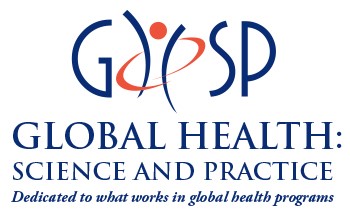More articles from ORIGINAL ARTICLE
- The Single-Visit Approach as a Cervical Cancer Prevention Strategy Among Women With HIV in Ethiopia: Successes and Lessons Learned
With the single-visit approach for cervical cancer prevention, women with positive “visual inspection of the cervix with acetic acid wash” (VIA) test results receive immediate treatment of the precancerous lesion with cryotherapy. The approach worked successfully for women with HIV in Ethiopia in secondary and tertiary health facilities, with high screening and cryotherapy treatment rates. Sustainability and appropriate scale-up of such programs must address wider health system challenges including human resource constraints and shortage of essential supplies.
- Meeting Postpartum Women’s Family Planning Needs Through Integrated Family Planning and Immunization Services: Results of a Cluster-Randomized Controlled Trial in Rwanda
Integrating contraceptive services into infant immunization services was effective, acceptable, and feasible without negatively affecting immunization uptake. Yet unmet need for contraception remained high, including among a substantial number of women who were waiting for menses to return even though, at 6 months or more postpartum, they were at risk of an unintended pregnancy. More effort is needed to educate women about postpartum return to fertility and to encourage those desiring to space or limit pregnancy to use effective contraception.
- Routine Immunization Consultant Program in Nigeria: A Qualitative Review of a Country-Driven Management Approach for Health Systems Strengthening
Despite challenges in material and managerial support, some state-level consultants appear to have improved routine immunization programming through supportive supervision and capacity building of health facility staff as well as advocacy for timely dispersion of funds. This country-led, problem-focused model of development assistance deserves further consideration.
- Casas Maternas in the Rural Highlands of Guatemala: A Mixed-Methods Case Study of the Introduction and Utilization of Birthing Facilities by an Indigenous Population
In an isolated mountainous area of Guatemala with high maternal mortality, an NGO-sponsored approach engaged communities to operate local, culturally appropriate birthing facilities and is achieving high and equitable utilization. Likely success factors:
Community engagement and ownership
Close location of facilities
Perceived high quality of services
Engagement of traditional birth attendants in the birthing process and as advocates for facility use
- A Dedicated Postpartum Intrauterine Device Inserter: Pilot Experience and Proof of Concept
Use of the inserter was found to be safe, with high fundal placement in 82% of cases. Complete expulsion occurred in 7.5% of cases and partial expulsion was detected in 10%, comparable with rates in other studies using standard IUD insertion techniques. Further study and use of the dedicated inserter may reveal increased convenience and reduced risk of infection among users and could improve acceptability of postpartum IUD provision among providers.
- Role of Social Support in Improving Infant Feeding Practices in Western Kenya: A Quasi-Experimental Study
Fathers and grandmothers who participated in separate nutrition dialogue groups supported mothers to improve infant feeding practices including dietary diversity, food consistency, and use of animal-source foods. Future studies should explore using a family-centered approach that engages mothers together with key household influencers.
- Mapping the Prevalence and Sociodemographic Characteristics of Women Who Deliver Alone: Evidence From Demographic and Health Surveys From 80 Countries
An estimated 2.2 million women surveyed in low- and middle-income countries between 2005 and 2015 gave birth alone. This practice was concentrated in West and Central Africa and parts of East Africa. Women who delivered with no one present were very poor, uneducated, older, and of higher parity. Experience from northern Nigeria suggests the practice can be reduced markedly by mobilizing religious and civil society leaders to improve community awareness about the critical importance of having an attendant present.
- Sexual Satisfaction, Performance, and Partner Response Following Voluntary Medical Male Circumcision in Zambia: The Spear and Shield Project
Most men and their partners reported increased or the same levels of sexual pleasure and improved or no change in penile hygiene post-VMMC. While half of men reported increased or no change in sexual functioning (orgasm, erections), one-third reported a decrease. Early resumption of sexual intercourse prior to complete healing was most closely associated with adverse outcomes, including decreased sexual functioning, satisfaction, and desire.
- Family Planning Supply Environment in Kinshasa, DRC: Survey Findings and Their Value in Advancing Family Planning Programming
A series of facility-based surveys that mapped all sites providing family planning services and that assessed readiness to provide services, using mobile phones, was feasible in a low-resource setting, contributing to mobilization of partners and increased donor support. Between 2012 and 2013, readiness to provide services increased from 44% of sites to 63%. Three factors most associated with productivity: type of facility (clinics more than hospitals or health centers), more years in operation, and number of methods available.
- Reducing Motor Vehicle-Related Injuries at an Arizona Indian Reservation: Ten Years of Application of Evidence-Based Strategies
Motor vehicle crashes decreased and seat belt use, including car seat use, increased in an American Indian and Alaska Native community through a multidisciplinary approach using strong partnerships among public health and law enforcement agencies; community outreach; mass media campaigns; and enactment and high-visibility enforcement of key laws, such as lowering the legal blood alcohol concentration limit for drivers and mandating use of occupant restraints.

